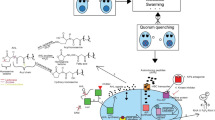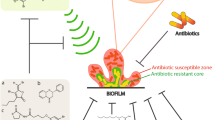Abstract
Most bacteria are able to grow in biofilms in which they effectively resist antimicrobial agents. This leads to a general problem, since traditional treatments of bacteria and prevention strategies become mostly ineffective. Novel strategies for biofilm inhibition are thus urgently required. Compounds interfering with cell-cell communication (quorum sensing) crucial for biofilm formation are promising targets for alternative strategies. Here, we report on a recently established assay enabling identification of quorum quenching compounds from environmental samples.
Similar content being viewed by others
Literatur
Castillo A (2015) How bacteria use quorum sensing to communicate. Nature Education 8:4
Wu H, Moser C, Wang H-Z et al. (2015) Strategies for combating bacterial biofilm infections. Int J Oral Sci 7:1–7
Römling U, Kjelleberg S, Normark S et al. (2014) Microbial biofilm formation: a need to act. J Inter Med 276:98–110
Martin C, Low WL, Gupta A et al. (2015) Strategies for antimicrobial drug delivery to biofilm. Curr Pharm Des 21:43–66
Kalia VC (2015) Quorum Sensing vs Quorum Quenching: A Battle with No End in Sight. Springer India
Grandclément C, Tannières M, Morâra S et al. (2016) Quorum quenching: role in nature and applied developments. FEMS Microbiol Rev 40:86–116
Fetzner S (2015) Quorum quenching enzymes. J Biotechnol 201:2–14
Rasmussen TB, Bjarnsholt T, Skindersoe ME et al. (2005) Screening for quorum-sensing inhibitors (QSI) by use of a novel genetic system, the QSI selector. J Bacteriol 187:1799–1814
Weiland-Bräuer N, Pinnow N, Schmitz RA (2015) Novel reporter for identification of interference with acyl homoserine lactone and autoinducer-2 quorum sensing. Appl Environ Microbiol 81:1477–1489
Weiland-Bräuer N, Kisch M, Pinnow N et al. (2016) Highly effective inhibition of biofilm formation by the first metagenome-derived AI-2 quenching enzyme. Environ Microbiol (eingereicht)
Djordjevic D, Wiedmann M, McLandsborough LA (2002) Microtiter plate assay for assessment of Listeria monocytogenes biofilm formation. Appl Environ Microbiol 68:2950–2958
Author information
Authors and Affiliations
Corresponding author
Additional information
Nancy Weiland-Bräuer 2000–2006 Biologiestudium (Diplom), Universität zu Kiel. 2006–2010 Promotion am Institut für Allgemeine Mikrobiologie (IFAM), Universität zu Kiel, dort 2010–2012 Postdoktorandin. 2012–2014 Elternzeit. 2014 Beginn der Habilitation am IFAM.
Ruth A. Schmitz-Streit 1984–1989 Biologiestudium (Diplom), Universität Marburg; 1990–1992 Promotion. 1993 Postdoktorandin in Marburg und 1994–1996 an der University of California, Berkeley, CA, USA. 1996–2001 Habilitation am Institut für Mikrobiologie und Genetik, Universität Göttingen. 2001–2004 Gruppenleiterin an der Universität Göttingen (Heisenberg-Stipendiatin). Seit 2004 Lehrstuhlinhaberin und Direktorin am Institut für Allgemeine Mikrobiologie (IFAM), Universität zu Kiel.
Rights and permissions
About this article
Cite this article
Weiland-Bräuer, N., Schmitz-Streit, R.A. Quorum quenching–Stören friede zwischenbakterieller Beziehungen. Biospektrum 22, 362–364 (2016). https://doi.org/10.1007/s12268-016-0698-8
Published:
Issue Date:
DOI: https://doi.org/10.1007/s12268-016-0698-8




